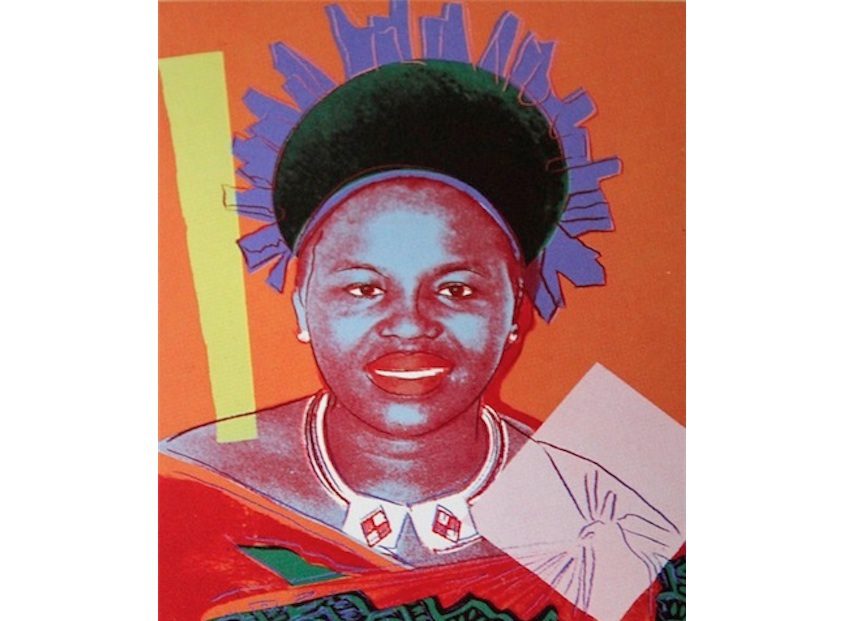An occasional column recalling the highs, low and sometimes messy in-betweens of mostly white folk on holiday in Africa. In this launch column, Andy Warhol, an American superstar, visits Africa, twice.

Andy Warhol, Queen Ntombi Twala Of Swaziland, 1985.
Long before he became an ironic refrain in a silver wig, Andy Warhol was a shy and untraveled illustrator who broke into the art scene with cutesy drawings of women’s shoes. In 1956, the same year Warhol had an ink-and-tempera shoe drawing included in the group exhibition ‘Recent Drawings USA’ at MoMA (the work was later rejected by the same institution when he gifted the work to its permanent collection), Warhol embarked on a two-month foreign tour with the production designer Charles Lisanby.
Flying west, the two New Yorkers – nominally lovers, certainly friends – stopped off in San Francisco and Honolulu before heading to Japan, and then Indonesia, Cambodia, Thailand, India, Egypt, and lastly Italy.
Warhol’s first visit to Africa was brief. He arrived in Cairo by plane in 1956, four years after a military coup d’état toppled the rule of Egypt’s King Farouk, inaugurating Egypt’s peculiarly military republic – one that endures to this day. Coincidentally, Egypt also opened its permanent pavilion in Venice’s Giardini in the same revolutionary year that Gamal Abdel Nasser and Muhammad Neguib led their republican coup.
Warhol arrived shortly after Neguib was ousted as leader and Nasser confirmed as the volatile republic’s new president. A wily politician with an awareness of Egypt’s geopolitical importance, particularly as a transit route for passing ships and cultural centre, Nasser cleverly parlayed Cold War rivalries for Egypt’s gain. Notwithstanding his pliable brand of politics, Nasser was clear about one thing: he despised Israel.
When Warhol touched down in Cairo, relations between Egypt and Israel were severely strained. The concrete apron at Cairo’s airport had become the stage for a military show of strength by Nasser’s government. “There were soldiers all over the place,” recalled Lisanby. Their plane was surrounded. Passengers were instructed to exit.
“Everyone had their passports removed,” writes Victor Bockris in Warhol: The Biography (2003), “and were marched out of the plane across a runway to the sound of screaming fighter jets, marching soldiers and shouted commands, and ushered into a Quonset hut where they were forced to watch a propaganda film, then marched back onto the plane.”
Warhol, who had originally intended to sightsee in Cairo and Luxor, was indifferent throughout the ordeal – “like a Zombie,” writes Bockris. He disembarked, watched the film, re-boarded the refuelled aircraft, and was in Rome by the next the morning.
The setting of Warhol’s first visit to Africa, an airport, also featured as the dominant location during a subsequent visit. After his first visit to Paris, where Warhol’s presence occasioned the “biggest transatlantic fuss since Oscar Wilde brought culture to Buffalo in the 1890s,” according to poet John Ashbery, Warhol travelled to London and Madrid. He bookended his European tour with a spontaneous visit to Tangier.
This Moroccan port city occupied a special place in the American imagination, in part due to the writings of Paul Bowles who first visited the city in 1931 on the advice of Gertrude Stein, and later settled there in 1947. By 1950, when journalist Charles J. Rolo published his article, “The New Bohemia”, Tangier was at the centre of a heady cultural movement where be-bop men and hipsters celebrated “the virtues of hashish” to slack-jawed Americans.
Details of Warhol’s visit are scant. In his 1980 memoir POPism, co-written with Pat Hackett, Warhol devotes a single sentence to his jaunt south across the Mediterranean: “Tangier smelled everywhere like piss and shit, but naturally everyone thought it was great because of all the drugs.”
As in Cairo, much of what is known about the trip occurred at the airport. Warhol and his entourage – socialite Edie Sedgwick, poet and photographer Gerard Malanga and promoter Chuck Wein – boarded a flight for home. At the last minute, Wein hastily exited the plane. “I realised he might have bolted just because he’d gotten one of those cosmic flashes that our plane was going to crash,” stated Warhol later, whose apolitical irony and droll witticisms anticipated the fragmented sound bite culture of Facebook and Twitter. “He was from Harvard, after all, which was early LSD country.”
Warhol, an artist who gave the exclamation “Gee!” literary weight, had undoubtedly wanted more. This is especially true of his first visit to Africa. Nasser’s impending war with the Israeli state, led by David Ben Gurion, however, clipped his sightseeing plans. He had also hoped to access more of Morocco than singularly its bohemian fringe.
“What kind of government do they have there, Bob?” Warhol asked his business associate and editor of Interview magazine Bob Colacello one day. This was in the 1970s. At the time, Warhol was coining it making paid portraits of celebrities, fat cats, monarchs and their missuses. They included the Shah of Iran. It was the cousin of the Iranian ambassador to Morocco who had intimated to Warhol that he could facilitate King Hassan II’s portrait. Tactful enquiries were made. Nothing happened.
Two years before he died, in 1987, Warhol had an ersatz encounter with African royalty when he signed off a portrait depicting Queen Ntfombi Twala of Swaziland –the mother of current Swazi regent, King Mswati III. The screen print was made entirely by studio assistants and formed part of the portfolio Reigning Queens, which depicted four female monarchs from Denmark, Swaziland, Britain and the Netherlands. The portrait series shows Warhol in late-career autopilot. “You can perfectly read ‘Reigning Queens’ as a monument to kitsch,” remarked Alfredo Jaar in an interview appearing in Regarding Warhol: Sixty Artists, Fifty Years (2012).
In the end, Warhol’s encounter with Africa can be summarized in a handful of words: guns, airports, drugs, and inaccessible monarchs. Gee!
Sean O’Toole is a writer and co-editor of CityScapes, a critical journal for urban enquiry. He lives in Cape Town, South Africa.
More Editorial